engine coolant OLDSMOBILE AURORA 2003 Owners Manual
[x] Cancel search | Manufacturer: OLDSMOBILE, Model Year: 2003, Model line: AURORA, Model: OLDSMOBILE AURORA 2003Pages: 387, PDF Size: 18.05 MB
Page 6 of 387
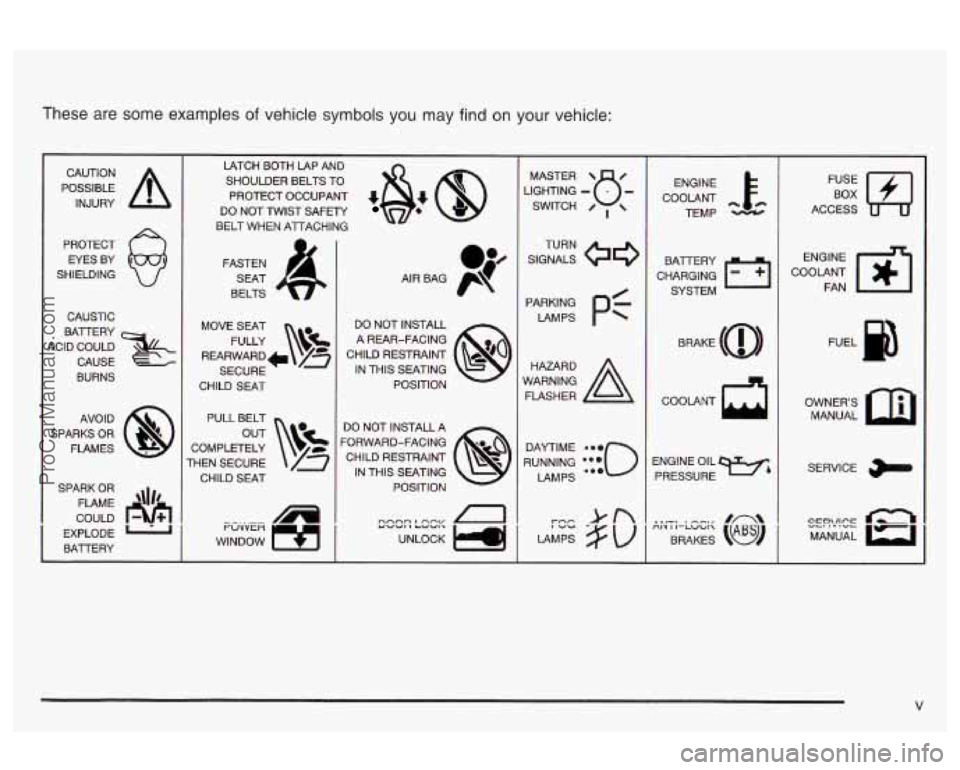
These are some examples of vehicle symbols you may find on your vehicle:
POSSIBLE A
CAUTION
INJURY
PROTECT EYES BY
SHIELDING
CAUSTIC
BATERY
4ClD COULD CAUSE
BURNS
AVO ID
SPARKS OR
FLAMES
SPARK
OR
COULD FLAME
EXPLODE
1'1
BAlTERY L
LATCH BOTH LAP AND SHOULDER BELTS TO
PROTECT OCCUPANT
*&: @
DO NOT TWIST SAFETY
BELT WHEN ATTACHING
MOVE SEAT FULLY
\!$%
REARWARD+ /z
SECURE
CHILD
SEAT
PULL BELT
COMPLETELY
rHEN SECURE CHILD SEAT
WINDOW
9 1
I ruvven "tl
I
1
DO NOT INSTALL A REAR-FACING
CHILD RESTRAINT
IN THIS SEATING
POSITION
DO NOT INSTALL A
'ORWARD-FACING CHILD RESTRAINT IN THIS SEATING POSITION
n
LIGHTING - MASTER SWITCH B- / ,
SIGNALS @e
TURN
LAMPS
P=-
RUNNING i{{o
DAYTIME LAMPS ENGINE
COOLANT TEMP
CHARGING BATTERY
SYSTEM
COOLANT
d
ENGINE OIL PRESSURE
9%
l.fJ
ACCESS
ENGINE
COOLANT FAN
OWNERS MANUAL
SERVICE
CC!?'!!CE Q MANUAL
ProCarManuals.com
Page 64 of 387
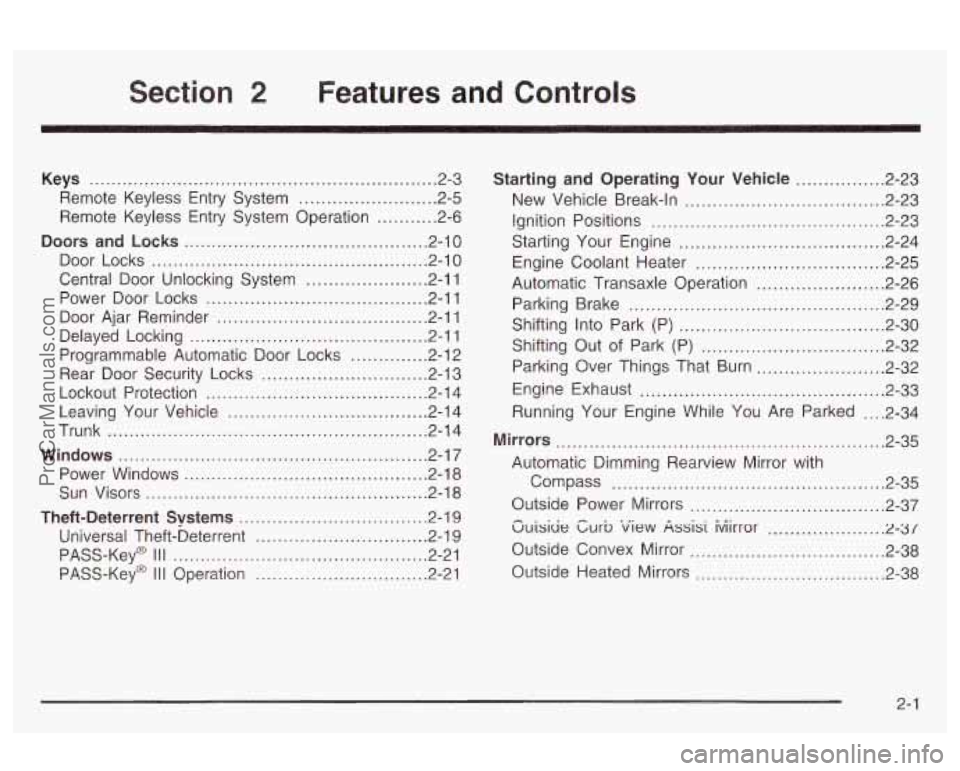
Section 2 Features and Controls
Keys ............................................................... 2-3
Remote Keyless Entry System
......................... 2.5
Remote Keyless Entry System Operation
........... 2.6
Doors and Locks
............................................ 2.10
Door Locks
.................................................. 2-10
Central Door Unlocking System
...................... 2-1 1
Power Door Locks
........................................ 2-1 1
Door Ajar Reminder
...................................... 2-1 1
Delayed Locking
........................................... 2-1 1
Programmable Automatic Door Locks
.............. 2-12
Rear Door Security Locks
.............................. 2-13
Lockout Protection
........................................ 2-14
Leaving Your Vehicle
.................................... 2-14
Trunk
.......................................................... 2-14
Windows
........................................................ 2-17
Power Windows
............................................ 2-18
Sun Visors
................................................... 2-18
Theft-Deterrent Svstems
................................. -2-1 9
Universal Theft-Deterrent
........ ........ 2-19
PASS-Key@
Ill Operation .................... .... 2-21
PASS-Key@
III ............................... .... 2-21 Starting and Operating
Your Vehicle
................ 2.23
New Vehicle Break-In
.................................... 2.23
Ignition Positions
.......................................... 2-23
Starting Your Engine
..................................... 2-24
Engine Coolant Heater
.................................. 2-25
Automatic Transaxle Operation
....................... 2-26
Parking Brake
.............................................. 2-29
Shifting Into Park (P)
..................................... 2-30
Shifting Out of Park (P)
................................. 2-32
Parking Over Things That Burn
....................... 2-32
Engine Exhaust
............................................ 2-33
Running Your Engine While You Are Parked
.... 2-34
Mirrors
.......................................................... -2-35
Automatic Dimming Rearview Mirror with
Compass
................................................. 2-35
Outside Power Mirrors
................................... 2-37
Outside Convex Mirror
................................... 2-38
Outside Heated Mirrors
.................................. 2-38
Guisiue Curb View Assist iviirror ..................... 2-31
2- 1
ProCarManuals.com
Page 88 of 387
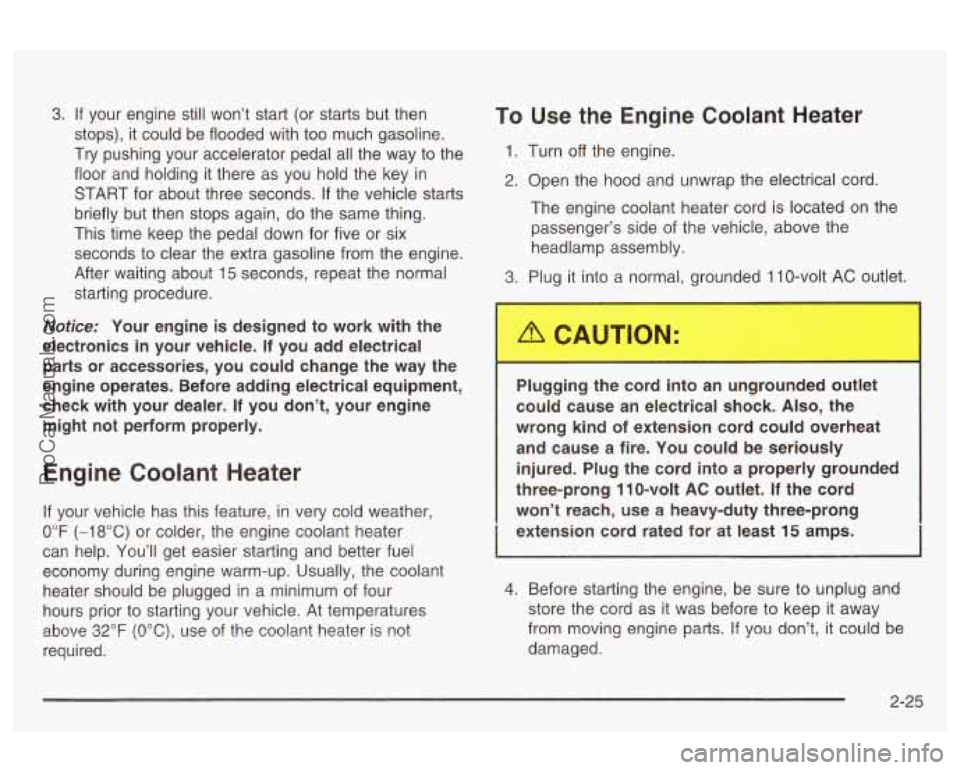
3. If your engine still won’t start (or starts but then
stops), it could be flooded with too much gasoline.
Try pushing your accelerator pedal all the way to the
floor and holding it there as you hold the key
in
START for about three seconds. If the vehicle starts
briefly but then stops again, do the same thing.
This time keep the pedal down for five or six
seconds to clear the extra gasoline from the engine.
After waiting about
15 seconds, repeat the normal
starting procedure.
Nofice: Your engine is designed to work with the
electronics in your vehicle. If you add electrical
parts or accessories, you could change the way the
engine operates. Before adding electrical equipment,
check with your dealer. If you don’t, your engine
might not perform properly.
Engine Coolant Heater
If your vehicle has this feature, in very cold weather,
0°F (-18°C) or colder, the engine coolant heater
can help. You’ll get easier starting and better fuel
economy during engine warm-up. Usually, the coolant
heater should be plugged in a minimum of four
hours prior to starting your vehicle. At temperatures
required.
&D\!P 32°F (““c), of the con!ant heater is not
To Use the Engine Coolant Heater
1. Turn off the engine.
2. Open the hood and unwrap the electrical cord.
The engine coolant heater cord is located on the passenger’s side of the vehicle, above the
headlamp assembly.
3. Plug it into a normal, grounded 1 10-volt AC outlet.
I
Plugging the cord into an ungrounded outlet
could cause an electrical shock.
Also, the
wrong kind of extension cord could overheat
and cause a fire. You could be seriously
injured. Plug the cord into a properly grounded
three-prong 110-volt
AC outlet. If the cord
won’t reach, use a heavy-duty three-prong
extension cord rated for at least 15 amps.
I
4. Before starting the engine, be sure to unplug and
store the cord as it was before to keep it away
from moving engine parts.
If you don’t, it could be
damaged.
2-25
ProCarManuals.com
Page 89 of 387
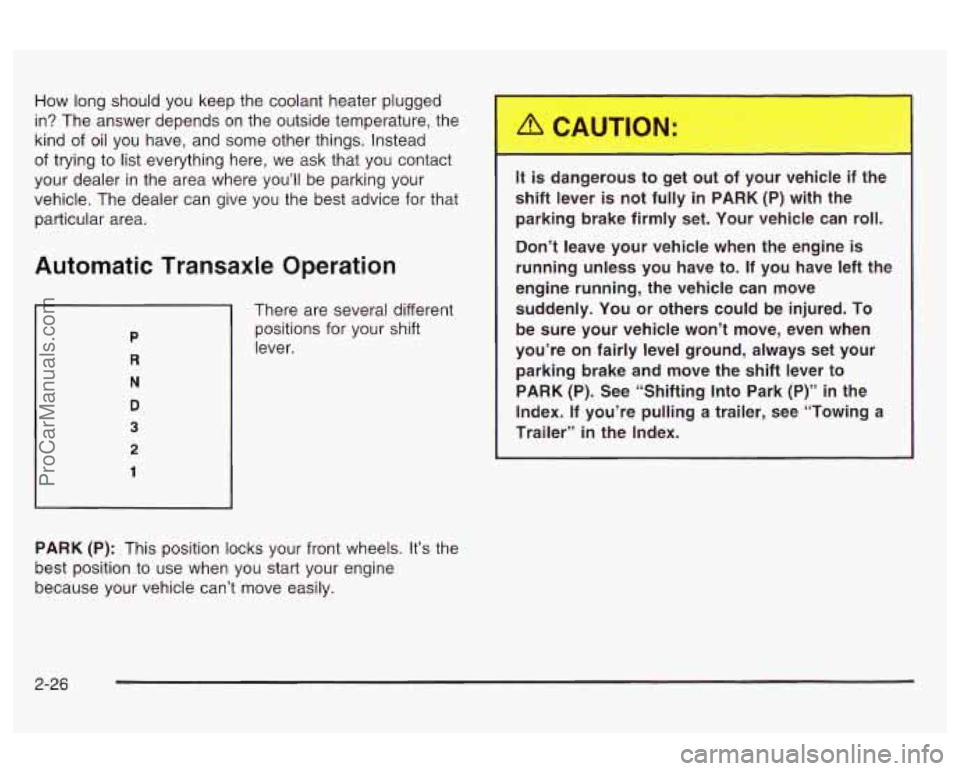
How long should you keep the coolant heater plugged
in? The answer depends on the outside temperature, the
kind of oil you have, and some other things. Instead
of trying to list everything here, we ask that you contact
your dealer in the area where you’ll be parking your
vehicle. The dealer can give you the best advice for that
particular area.
Automatic Transaxle Operation
There are several different
positions for your shift
lever.
__ js dangerous to get 01 of your veh f the
shift lever is not fully in PARK (P) with the
parking brake firmly set. Your vehicle can roll.
Don’t leave your vehicle when the engine
is
running unless you have to. If you have left the
engine running, the vehicle can move suddenly.
You or others could be injured. To
be sure your vehicle won’t move, even when
you’re on fairly level ground, always set your
parking brake and move the shift lever to
PARK (P). See “Shifting Into Park
(P)” in the
Index. If you’re pulling a trailer, see “Towing a
Trailer”
in the Index.
PARK (P): This position locks your front wheels. It’s the
best position to use when
you start your engine
because your vehicle can’t move easily.
2-26
ProCarManuals.com
Page 114 of 387
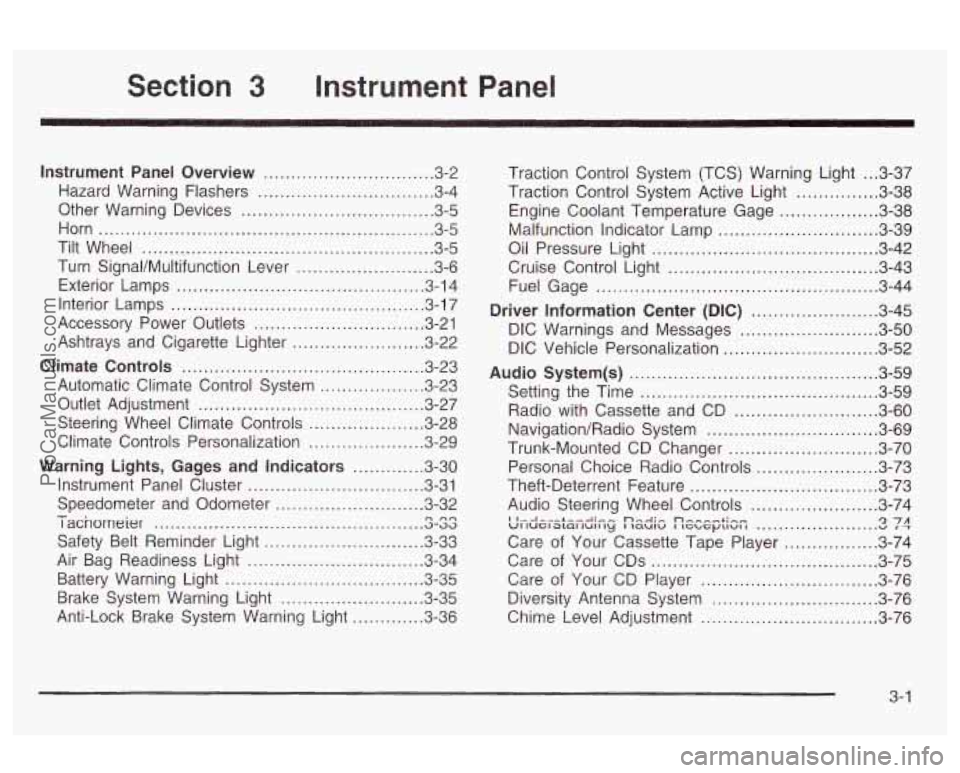
3 Instrument Panel
Instrument Panel Overview .............................. -3-2
Hazard Warning Flashers
................................ 3-4
Other Warning Devices
................................... 3-5
Horn
............................................................. 3-5
Tilt Wheel
..................................................... 3-5
Turn SignaVMultifunction Lever
......................... 3-6
Exterior Lamps
............................................. 3-14
Interior Lamps
.............................................. 3-17
Accessory Power Outlets
............................... 3-21
Ashtrays and Cigarette Lighter
........................ 3-22
Climate Controls
............................................ 3.23
Automatic Climate Control System
.................. 3-23
Outlet Adjustment
......................................... 3-27
Steering Wheel Climate Controls
..................... 3-28
Climate Controls Personalization
..................... 3.29
Warning Lights, Gages and Indicators
............. 3-30
Instrument Panel Cluster
............................... -3-31
Speedometer and Odometer
........................... 3-32
I acnorneier .-..
Safety Belt Reminder Light ............................. 3-33
Air Bag Readiness Light
................................ 3-34
Battery Warning Light
.................................... 3.35
Brake System Warning Light
.......................... 3.35
Anti-Lock Brake System Warning Light
............. 3-36
- n no .................................................
Traction Control System (TCS) Warning Light ... 3.37
Traction Control System Active Light
............... 3.38
Engine Coolant Temperature Gage
.................. 3.38
Oil Pressure Light
......................................... 3.42
Cruise Control Light
...................................... 3.43
Fuel Gage
................................................... 3.44
Driver Information Center
(DIC) ....................... 3.45
DIC Warnings and Messages
......................... 3.50
DIC Vehicle Personalization
............................ 3.52
Audio System(s)
............................................. 3.59
Setting the Time
........................................... 3.59
Radio with Cassette and CD
.......................... 3.60
Navigation/Radio System
............................... 3.69
Trunk-Mounted CD Changer
........................... 3-70
Personal Choice Radio Controls
...................... 3.73
Theft-Deterrent Feature
.................................. 3.73
Audio Steering Wheel Controls
....................... 3.74
Care of Your Cassette Tape Player
................. 3-74
Care of Your CDs
......................................... 3-75
Care
of Your CD Player ................................ 3-76
Malfunction Indicator
Lamp
............................. 3.39
I I...I-.-L--A.- ... n,.-J:, n-, --+in- VI luel awl lull ty I laulu I IGL, G~LIUI I u 1 T '2 7A ......................
Diversity Antenna System .............................. 3.76
Chime Level Adjustment
............................... -3-76
3-
1
ProCarManuals.com
Page 151 of 387

Traction Control System Active
Light
United States
I
Canada
When your traction control system is limiting wheel spin,
this light will come on. Slippery road conditions may
exist
if the traction control system active light comes on,
so adjust your driving accordingly.
The light will stay on for a few seconds after the traction
control system stops limiting wheel spin.
Engine Coolant Temperature Gage
United States Canada
This gage shows the engine coolant temperature.
If the
gage pointer moves into the shaded warning zone,
your engine is hot.
To prevent engine overheating, the air conditioning
compressor will turn
off automatically, a fast-pulsed
chime will sound, and the message ENGINE HOT
... A/C
OFF will appear in the Driver Information Center
(DIC).
As the engine cools down, the air conditioning
compressor will automatically turn back on.
3-38
ProCarManuals.com
Page 152 of 387

If the coolant temperature is over 262°F (1 28"C), the
message HOT
... IDLE ENGINE will appear. It means you
should reduce the engine load and speed to prevent
the engine from overheating.
If the coolant temperature is over 268°F (1 31 "C), the
message HOT
... STOP ENGINE will appear. It means
that your engine coolant has overheated. You should
pull
off the road, stop your vehicle and turn off the
engine as soon as possible.
Your vehicle is equipped with an Overheated Engine
Protection Operating Mode. See
Engine Overheating on
page
5-28 for more information.
If your coolant level is low, the message LOW ENGINE
COOLANT will appear on the Driver Information
Center. Check your coolant level as soon as possible.
See
Engine Coolant on page 5-24.
Malfunction Indicator Lamp
Check Engine Light
CHECK
United States
Canada
Your vehicle is equipped with a computer which
monitors operation
of the fuel, ignition and emission
control systems.
3-39
ProCarManuals.com
Page 234 of 387

Section 5 Service and Appearance Care
Service ............................................................ 5-3
Doing Your Own Service Work
........................ -5-4
Adding Equipment to the Outside of Your
Vehicle
...................................................... 5-4
Fuel
................................................................ 5-5
Gasoline Octane
............................................ 5-5
Gasoline Specifications
.................................... 5-5
California Fuel
............................................... 5-6
Additives
......................................... ...... 5-6
Fuels in Foreign Countries
........................... 5-7
Filling Your Tank
........................................ 5-7
Filling a Portable Fuel Container
..... . 5-11
the Hood
.................................................... 5-12
Hood Release
.............................................. 5-13
Engine Compartment Overview
....................... 5-14
Engine Oil
................................................... 5-15
Engine Air Cleaner/Filter
................................ 5-21
P,L!tSrn2.tlC Tr2!ns2x!n !=!!lid ............................. .- E;-33 --
Engine Coolant ............................................. 5-24
Coolant Surge Tank Pressure Cap
.................. 5-28
Engine Overheating
....................................... 5-28
Cooling System
............................................ 5-31
.W indshieid .Washer Fiuid 5-36
Checking Things Under
Power Steering Fluid
..................................... 5-37 ~ ................................
Brakes ........................................................ 5.39
Battery
........................................................ 5.42
Jump Starting
............................................... 5-44
Headlamp Aiming
.............................. ...... 5-50
Bulb Replacement ......................................... -5-54
Halogen Bulbs
............................................. -5-54
Headlamps
................................................. -5-55
Front Turn Signal and Parking Lamps
.......... 5-57
Taillamps, Turn Signal, Stoplamps and
Back-up Lamps
..................................... 5-58
Replacement Bulbs
....................................... 5-58
Windshield Wiper Blade Replacement
.............. 5-59
Tires
.............................................................. 5-60
Inflation
-- Tire Pressure ................................ 5-60
Check Tire Pressure System
.......................... 5-62
Tire Inspection and Rotation
........................... 5-63
When It Is Time for New Tires
....................... 5-65
Buying New Tires
......................................... 5-66
UIIIIUIIII I Ilt: Uudllly uldullly d-UI
Wheel Alignment and Tire Balance .................. 5-68
Wheel Replacement
...................................... 5-68
Tire Chains
................................................. -5-70
If a Tire Goes Flat ........................................ 5-70
Changing a Flat Tire
..................................... 5-71
Compact Spare Tire
5-81
I I.-:+- T. n . ._I.&. . n.-- -I:__ _. re7 ..........................
- ......................................
5- 1
ProCarManuals.com
Page 245 of 387

Checking Things Under
the Hood
An electric fan under the hood can start up
and injure you even when the engine is not
running. Keep hands, clothing and tools away
from any underhood electric fan.
I I
/t CAUTION:
I
Things that burn can get on hot engine parts
and start a fire. These include liquids like fuel,
oil, coolant, brake fluid, windshield washer and
other fluids, and plastic or rubber. You or
others could be burned. Be careful not to drop
or spill things that will burn onto a hot engine.
5-1 2
ProCarManuals.com
Page 248 of 387

A. Engine Compartment Fuse Block
B. Windshield Washer Fluid Reservoir
C. Engine Coolant Surge Tank
D. Remote Positive (+) Battery Terminal
E. Power Steering Fluid Reservoir
F. Passenger Compartment Air Filter
G. Remote Negative (-) Terminal
H. Engine Oil Fill Cap
I. Engine Oil Dipstick
J. Brake Fluid Reservoir
K. Automatic Transaxle Fluid Dipstick
L. Engine Air CleanedFilter
.
If the CHECK OIL LEVEL message appears on the
instnJment chster, it me;lns yn~~ need to check
your engine oil level right away. For more information,
see
DIC Warnings and Messages on page 3-50.
You should check your engine oil level regularly; this is
an added reminder.
5-1 5
ProCarManuals.com